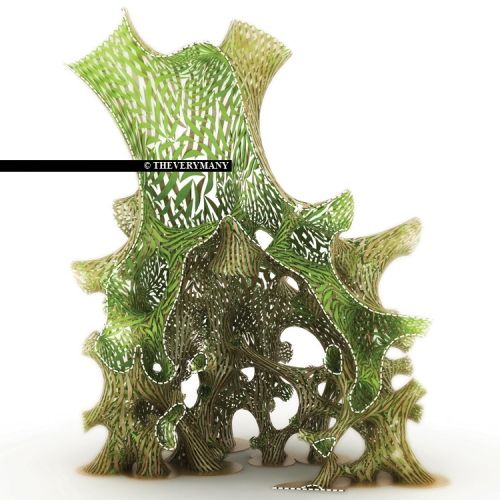A look back at the algorithms, software, quotes, and projects that made up 2010.
Algorithm of the year
Itry to solve almost any problem with a Genetic Algorithm. And when you have a hammer as big as a Genetic Algorithm, with almost 3.7 billion years of user testing, it is hard not to see many Genetic Algorithm nails sticking out all over the place. On any other year I would have given this to the Genetic Algorithm, but 2010 has really been the year of the Spring Algorithm. There have been some fascinating projects: Kangaroo physics (above), Ander's work with the Maya Nucleus Engine, projects by Supermanouver and Kokkugia, and even I dropped the genetic algorithm and picked up the spring algorithm for a while. Also all those tensegrity projects you have seen everywhere this year: spring algorithm.
What I particularly like about the spring algorithm is that it is our algorithm. Most of the other algorithms are hand-me-downs from computer science, in a list that contains all my old favorites: Cellular Automata, Genetic Algorithms, Simulated Annealing, L-systems and Shape Grammars. But there is something inherently spatial about the spring algorithm that makes it useless for anything other than physical stuff, and I like that.
Software of the year
Draftsight almost won this by completely pissing on Autodesk's release of Autocad for OSX, by launching an almost identical product, weeks earlier, for thousands of dollars less (free). Not only that, Draftsight actually works. While Draftsight certainly had the biggest bang this year, Grasshopper has spent the year slowly cranking out significant features. It started with the new plugin system, which has grown into a sizable array of tools, including: Kangaroo, Rabbit, and Weaver Bird. Add onto that the release of Galapagos for Genetic Algorithms, and the re-release of clusters, 2010 has been Grasshoppers year.
Walk into any university final year exhibition and you are certain to find a Grasshopper definition lurking in more than one of the panels. I spoke to some Autodesk developers this year and you could tell that Rhino and Grasshopper - despite their small market share - had really fired Autodesk up. Autodesk desperately wants to be cool again. In the long run they might be because Grasshopper seems to have taken the concept of graph based parametric modelling almost to its conclusion. I think the next major development in computational architecture will not be a more refined version of Grasshopper, but an entirely new take on it. Autodesk, having acquired Robert Aish, have quietly been working on some physics based modellers and the new Designscript project. And as we saw with Autoplan, it wouldn't be the first time Autodesk have come from behind to conquer a market, that is if Draftsite/Dassault don't get there first.
Call of the year
How about you? Do you have convictions about what constitutes a meaningful for contemporary architecture? Or are you unsure? (Do whatever we feel like??? What then? Or what people want??? What do they want?) Do you have the opportunity to work according to your own convictions - if you have convictions? Are you able and willing to state the principles that underly your work? Could these just be valid for you? Who is Daniel Morales to have principles all for himself? Which client should by into Daniel Morales' personal perspective???
18th of May, Schumacher decides the best defense of parametricism is to go on the offensive against Daniel Morales. With comments like this, rightly or wrongly, 2010 was the year of parametricism.
Project of the year

10 Sukkah City by Marc Fornes at The Very Many.
Fornes has been producing projects in this vein for years, and in 2010 it seems everyone caught on making their own large-scale-installation-of-mass-customised-lazer-cut-pieces-distributed-on-irrational-surfaces.
I like 10 Sukkah City because it is beautiful. I like it because the surface is mathematically interesting, and difficult to panel around the holes. But I mostly like 10 Sukkah city because it collapsed. 10 Sukkah City represents where computational architecture is today: we can make beautiful structures, we can design with fancy and complex mathematics using computation, but we are struggling to deploy them at building scale, we are struggling to embed function, and we have no idea how to calculate the structural load. These problems are masked in a large-scale installation (whereas they are not on a building), the collapse of 10 Sukkah City pulled back that mask a little bit and gave an honest insight into where we stand at the end of 2010.

Please nominate your 'of the year' in the comments. I hope you all have an enjoyable new year. I am taking a short break back to New Zealand but will be back here shortly.
Benjamin
It seems to me that architects tend to use computational methods like genetic and spring algorithms not only because they have a clear formal relationship but also because they want something robust and flexible, and are less concerned with runtimes and perfect optimization. Call it the difference between science and applied engineering, I guess.
Kris Hammerberg
You know what they always say, "When all you have is a genetic algorithm, everything starts to look like a problem domain with a complex fitness landscape."
Daniel
@ Benjamin
Yea I agree that the use of GA and springs is more than just a formal relationship. Your most recent post on Autodesk Vasari (http://work.permanentriot.com/2011/01/autodesk-vasari-a-good-step/) shows off how speed is far more important to early stage design than precision.
@ Kris
Exactly the words I needed!
Bill
http://theverymany.com/constructs/10-nstrip/